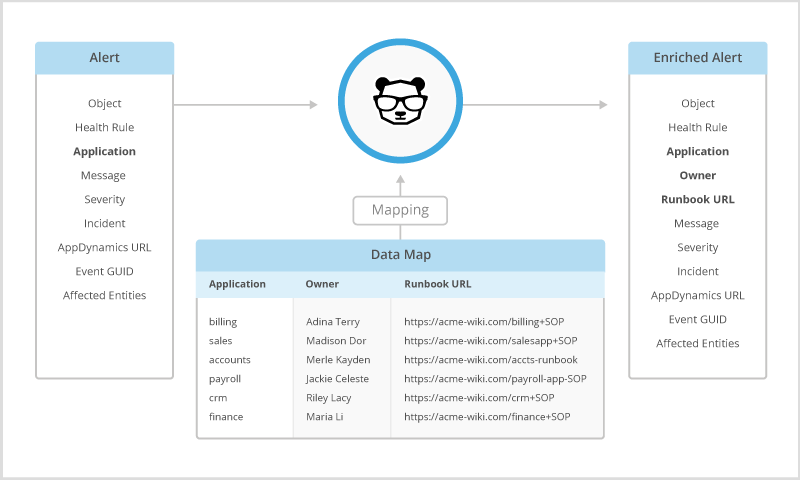Best Practices for Mapping Enrichment
Mapping enrichment allows you to upload a CSV to map tag values to an enrichment table. Incoming alert data will be compared to the values in query_tag columns. If a match is found, the related tag will be updated with a value from the result_tag column.
Mapping enrichment items are added automatically to existing tags upon the upload of a mapping enrichment table with matching result_tag column names. If a map contains a result_tag column name that does not match an existing tag, a new tag is automatically created for the enrichment item.
You can define a mapping enrichment with the Alert Enrichment API using these resources:
Enrichments object—defines the schema for your enrichment table. The schema determines how the information in each column of the table will be used in the enrichment process—as a query field, to match a value in the incoming alert, or as a result field, to enrich the alert.
Map endpoint—allows you to upload and maintain a mapping table that follows a given enrichments schema.

Step 1: Define The Mapping Structure
For a mapping enrichment, the Enrichments object defines how the information in each column of the table will be used in the enrichment process:
Query field—used to match a value in the incoming alert.
Result field—used to enrich the alert.
To define the mapping structure for a new enrichment:
Send a
POSTrequest to/enrichments. Specify thetypeasmapping.For each column in your data table, specify the name and whether to use the values as aquery_tagor aresult_tag. The request creates a newEnrichmentsobject for this mapping enrichment schema.Token value
Be sure to replace
${token}with the corresponding value for your organization.Copy the
idvalue from the response body. You will use it to identify this schema when you upload and update the mapping data.
Step 2: Upload The Mapping Data
After you create an Enrichments object that defines its structure, you can upload the table of the mapping data. For example, suppose that the Billing and Sales applications both have owners and remediation procedures. You can upload a table with three rows—one row for the column names and one row for each application.
To upload the mapping data for an enrichment:
Send a
POSTrequest to/enrichments/${id}/map. Replace${id}with the value you copied from the response body in Step 1 and${token}with the corresponding value for your organization.Mapping data
The mapping data must be sent as comma-separated values (CSV) in the body of the request or in a CSV file. Ensure the data follows the structure you defined in Step 1 and has the same column names.
Enriched tag for analytics
If your organization would like to accurately visualize enrichment rates in Unified Analytics, you must include 2 enrichment flag columns in the CSV:
An
enrichedorenrichmentcolumn with true/false rows, where true means alerts that match on that row should be considered enriched.A
<map name>column withenrichedorenrichmentin each row (whichever was the name of the previous column), to add the enriched quality to any alert matched on the map.
The request initiates an asynchronous job to upload the table and creates a Job object to track its progress.
The payload must end with an empty new line. Make sure there are no spaces before the closing quotation marks on the last line.
Copy the
trigger_urivalue from the response body. You will use it to check the status of the upload.Send a
GETrequest to the${trigger_uri}to verify that the upload has completed successfully. Replace${trigger_uri}with the value you copied from the response body and${token}with the corresponding value for your organization.(Recommended) Send test alerts to ensure that the mapping enrichment works as expected. For example, you can run the following command to send matching test alerts via the Alert API.
Resolve any test alerts, as necessary.
Step 3. Maintain the Mapping Data
As your team and infrastructure changes, you may need to update the values for your mapping enrichment. Depending on what changes you want to make, you can either completely replace the existing table, change only specific rows in the table, or create a new enrichment to change the structure.
To completely replace the existing table but keep the same structure, repeat Step 2. Upload the Mapping Data.
To change only specific rows in the existing table:
Send a
PATCHrequest to/enrichments/${id}/map. Replace${id}with the value you copied from the response body in Step 1 and${token}with the corresponding value for your organization. For each row, specify the operation to perform and the data required to perform the operation. The request initiates an asynchronous job to upload the table and creates a Job object to track its progress.Copy the
trigger_urivalue from the response body. You will use it to check the status of the update.Send a
GETrequest to the${trigger_uri}to verify that the update has completed successfully. Replace${trigger_uri}with the value you copied from the response body and${token}with the corresponding value for your organization.(Recommended) Send test alerts to ensure that the mapping enrichment works as expected.
Resolve any test alerts, as necessary.
To change the structure of your mapping data:
Deactivate the existing enrichment by sending a
POSTrequest to/enrichments/${id}. Replace${id}with the value you copied from the response body in Step 1 and${token}with the corresponding value for your organization. Setactivetofalse.Create a new mapping enrichment, starting from Step 1: Define The Mapping Structure.